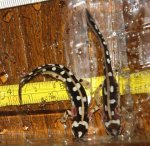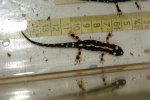- Joined
- Oct 14, 2004
- Messages
- 3,259
- Reaction score
- 63
- Points
- 48
- Location
- Bristol
- Country
- United Kingdom
Has anyone tried forcing kaiseri metamorphs to remain aquatic? I'm raising a few hundred and the first batch of morphs crawled up the walls but within a couple of days went back to the water and haven't left since.
Aquatic morphs will be much easier with regards to space and food.
Aquatic morphs will be much easier with regards to space and food.



